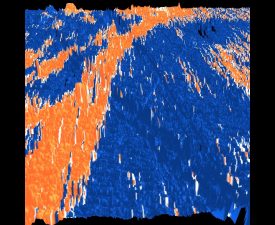
Image of Cu Ag surface potentialsLooking like the Blue Turf at the nanoscale, regions of difference metals are revealed by their electrical properties in a polished surface.
18 January 2019 – Corey Efaw, a PhD student in the Micron School of Materials Science and Engineering at Boise State, and a team of researchers led by Prof. Mike Hurley, have developed a new methodology for improved quantitative characterization of material properties. The team used a type of atomic force microscopy (AFM) known as scanning Kelvin probe force microscopy (SKPFM), which can be used to study surface electrical properties with nanometer resolution. Through a careful study, the team established the need for properly referenced and calibrated probe conditions for reliable measurement of Volta potential differences, which are important electrical properties that influence the corrosion of metal alloys. First-principles calculations, performed by PhD student Thiago da Silva and directed by Prof. Lan Li, were in agreement with the measured surface potentials, providing a direct link between experimental and computational materials research. The team also carefully evaluated the performance of multiple types of probes that are used for these measurements to help determine which probes are most suitable for different applications. With this study, the researchers hope future measurements from different labs will be more repeatable and more reliable.
This open access work was published in the Journal of the Electrochemical Society as part of a Focus Issue on Electrochemical Techniques in Corrosion Science in Memory of Hugh Isaacs: Corey M. Efaw, Thiago da Silva, Paul H. Davis, Lan Li, Elton Graugnard, and Michael F. Hurley, “Toward Improving Ambient Volta Potential Measurements with SKPFM for Corrosion Studies,”
J. Electrochem. Soc. 166: C3018-C3027 (2019); doi:10.1149/2.0041911jes